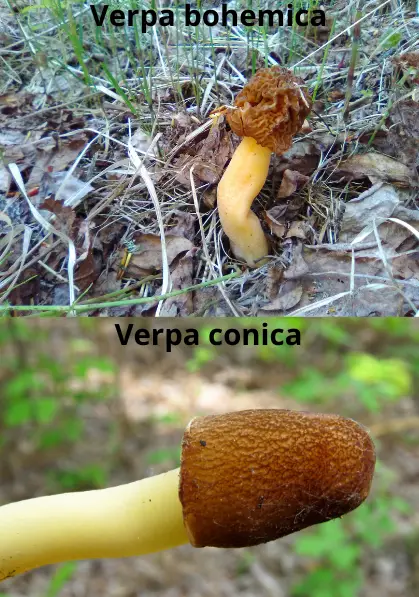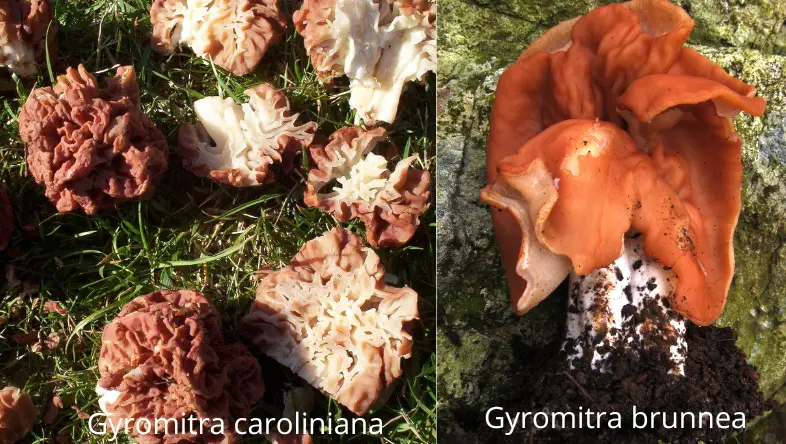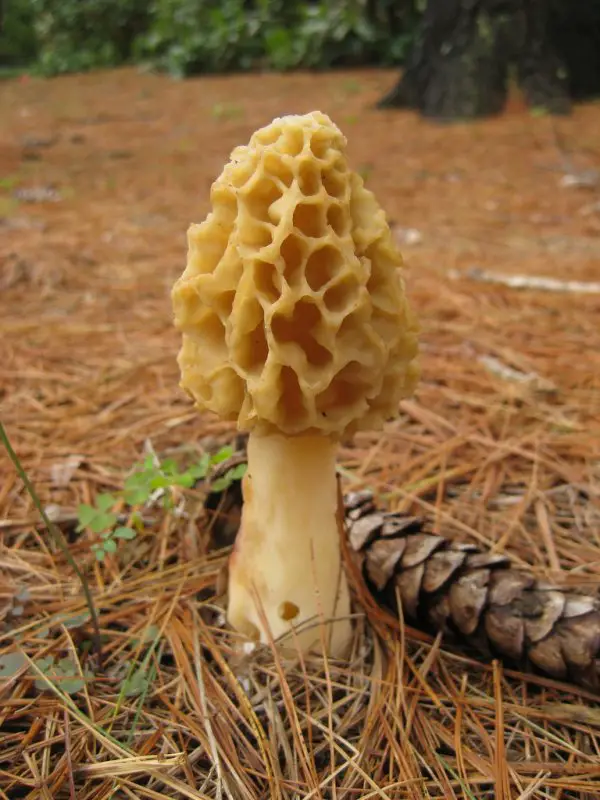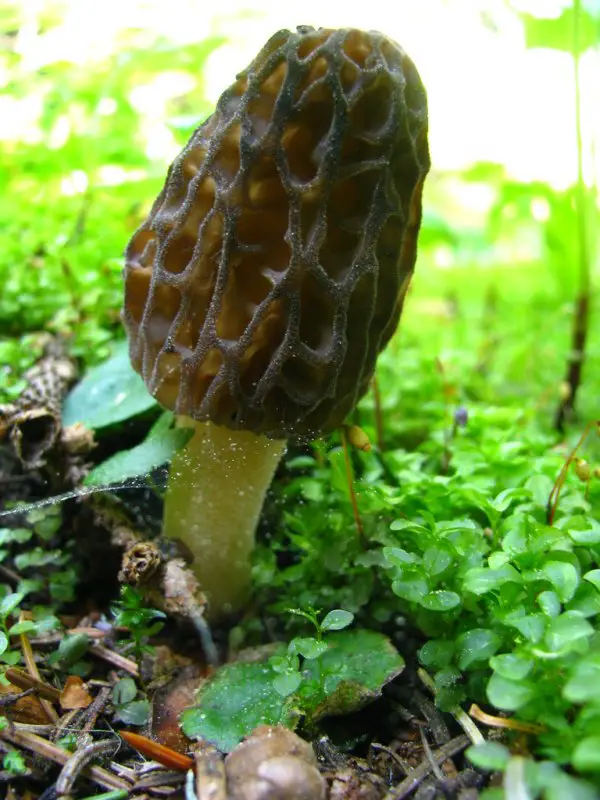A half free morel is an edible type of wild mushroom. Considered one of the true morels, they are distinguished by their odd shape and having only half the cap attached to the base. Thus being ‘half-free.’ Like all morel mushrooms, half free morels must be cooked before consumption.
The bottom half of the cap of a half free morel hangs down from the white, hollow base and resembles a skirt. These conical caps are yellowish-brown in color with a honeycomb appearance.
The outer portion of the cap is ridged and pitted and responsible for producing spores that aid reproduction.
There are two species of North American half free morels:
What Are You Foraging For Right Now?
We're thrilled to hear your ideas. What would you like to submit today? Feel free to share your thoughts and experiences with us.
- Morchella punctipes
- Morchella populiphila
These half free morels are often referred to as peckerheads and until recently were classified as Morchella semilibera. It’s since been determined, however, that the growth of M. semilibera is specific to areas of Europe.
If you intend to go mushroom hunting in North America, you’re most likely to find half free morels in Tennessee up through Michigan, Wisconsin, Vermont, and even Oklahoma.
Morel hunting tends to be most successful in wooded areas and areas where oak trees grow freely, as well as aspen, elm, ash, and other hardwoods.
Check out our video on how to identify and cook half free morels.
Can You Eat a Half Free Morel?
Half free morels are among the edible mushrooms. Half free morels must be cooked before eating.
All morel species have a mild level of toxicity. In edible morels, this toxin is destroyed during the cooking process.
Morels are highly prized as an addition to many recipes. However, since harvesting them is time-consuming, these fungi can be costly when purchased.
Nonetheless, the distinctive, light, earthy flavor makes morels a sought-after delicacy, and aficionados will tell you they’re worth every penny.

As a bonus, morels are quite nutrient-dense. The array of vitamins and minerals within a half free morel, and morel mushrooms in general, will vary depending upon the soil in which they’re growing.
With that said, you can count on morels being loaded with:
- Copper
- Zinc
- Manganese
- Vitamin D
- Folate
- Niacin
These fungi also contain a substantial amount of protein and fiber, making morels mini nutritional powerhouses.
Half Free Morel Vs Verpa
The half free morel shouldn’t be confused with its false morel cousins Verpa conica and Verpa bohemica.
Verpas are sometimes referred to as early morels; they fruit at the same time as the free morels and bear a resemblance that can make it easy to mistake one for the other.
This can be a costly mistake. False morels contain a toxin, gyromitrin, that can have serious side effects when ingested.
While half free morels are considered true morels, Verpa is a false morel with two notable differences:
- Cap shape and attachment
- Edibility
These lookalikes have caps that are loosely but fully attached to the stem at the top of the cap rather than the base of the cap. This is often referred to as a thimble cap.
For the novice mushroom hunter, the cap attachment can be the easiest way to tell the difference between the two.
And if you’re truly unsure, cutting through the stem can solidify identification:
- Half free morels are hollow inside
- Verpas have a cottony, pithy center

Where Does a Half Free Morel Grow?
Because half free morels grow wild and aren’t farmed, mycologists and mushroom hunters know that tracking down this fungus can take time and patience.
Morels are typically found during the spring. Their growth and growing season are tied heavily to soil temperature. Once soil temperature reaches 62 -65ºF, morels will stop growing.
They can grow in pastures, fields, groves of trees, or meadows. Half free morels, in particular, are most often found in or near groves of hardwoods.
Foraging Half Free Morels
When foraging for half free morels, caution is the rule.
If you’re new to mushroom hunting, the guidance of an experienced individual and a reliable field guide is highly recommended.
Why?
There are many morel lookalikes and mistakes can mean extreme digestive discomfort and potentially serious side effects.
Poisonous false morels like Gyromitra caroliniana and G. brunnea can fool novice mushroom enthusiasts, meaning proper identification is crucial.
These imposters are generally a dark, reddish color and have wrinkled, lobed caps. They can also be distinguished by the composition of the stalks, which are solid rather than hollow.

If you are lucky, you might also run across the edible yellow morel, M. esculentoides, or black morel, M. angusticeps while foraging. These will have larger caps with the bottom of the cap in both species fully attached to the stalk.
Since morels are so highly affected by soil composition, ensure you hunt in areas free of external toxins.


What Can You Do With Half Free Morels?
Like all morel mushrooms, half free morels must be cooked to be enjoyed. Before cooking or drying, thoroughly clean and inspect your morels for bugs or worms. Once cleaned, we recommend slicing off the tough bottom of the morel.
Half free morels pair well with butter or as an addition to sauces and pasta. They have an earthy, meaty flavor that adds richness to many dishes.
- One highly lauded recipe is asparagus and morel risotto.
If you aren’t ready to use your harvest right away, it’s advisable to dehydrate your half free morels.
Because of their high moisture content, a pound of fresh morels can reduce to just over an ounce once dried. The drying process also concentrates the flavor and adds longevity to this prized ingredient.
Lorin is a writer, photographer and nature enthusiast in Sacramento, CA. In addition to gardening, she makes a regular practice of forging for edible plants and flowers. Nature nourishes if you know where to look.

